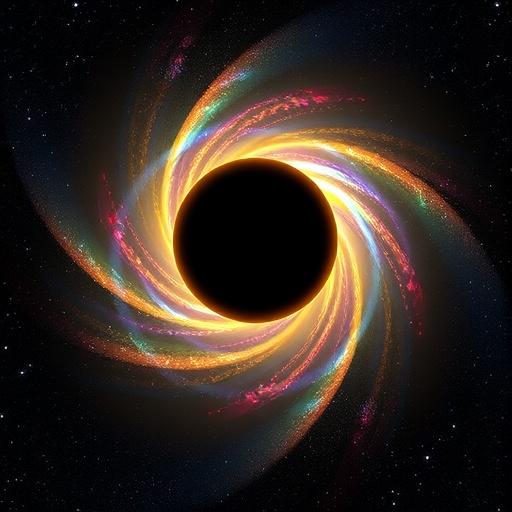A groundbreaking study led by a research team from the Purple Mountain Observatory (PMO) has emerged from the gravitational-wave event GW230814, marking a critical observational test of the black-hole area law proposed by Stephen Hawking in 1971. This law posits that the total area of a black hole’s event horizons cannot decrease over time, a concept that becomes particularly relevant during the merger of two black holes. The challenge has long been the complexity of accurately measuring the masses and spins of both progenitor and resulting black holes, which directly influence their horizon areas.
In this investigation, the PMO team targeted the high signal-to-noise ratio event GW230814, which was cataloged in the fourth gravitational-wave transient catalog. The coalescence of black holes happens in three distinct phases: inspiral, merger, and ringdown. The inspiral phase is characterized by the two black holes spiraling toward one another, gradually increasing their speed. Then, the merger phase ensues, marked by the tumultuous merging of these massive entities, a process that lies in a highly nonlinear regime and could exhibit deviations from the predictions of general relativity. Finally, the ringdown phase is when the newly formed black hole settles into a stable state, dissipating energy and smoothing out irregularities.
Recognizing the potential insights that the merger phase could provide, the PMO researchers conducted independent parameter inference focusing on both the inspiral and ringdown phases of GW230814. This meticulous approach allowed them to derive robust constraints on the masses and spins of both the original black holes and the final merged black hole. By ascertaining these parameters, the researchers effectively calculated the horizon areas that are pivotal in assessing compliance with Hawking’s area law.
Throughout their analysis, the authors were diligent in addressing key uncertainties that could cloud their findings. They took into account factors such as sky-location error, waveform-template systematic effects, the selection of ringdown models, and the critical time boundaries defining the end of the inspiral phase and the beginning of the ringdown. This thorough consideration of uncertainties served to enhance the confidence in their results.
The noteworthy outcomes of this detailed analysis led to a powerful conclusion. After extensive examination and refutation of various uncertainties, the researchers found that there exists a remarkably high posterior probability — about 4.1σ significance — that the horizon area of the newly formed black hole exceeds the combined horizon areas of its progenitors. This evidence serves as a substantial endorsement of the black-hole area law, underscoring the self-consistency of general relativity, particularly in the highly dynamic regimes experienced during black-hole mergers.
The confirmation of Hawking’s area law is not merely a validation of a fundamental concept within black-hole physics; it also reinforces our broader understanding of gravitational dynamics under extreme conditions. This might pave the path for deeper inquiries into black-hole thermodynamics, potential quantum-gravity corrections, and more stringent tests of gravitational theory in environments characterized by intense astrophysical phenomena.
The implications of this observational test extend far beyond just black hole physics. The findings underline the robustness of general relativity and its predictive power even in scenarios filled with extreme gravitational forces and energetic phenomena. These observations could act as a springboard for future studies that strive to unravel the complexities of black holes and their intricate behaviors, thus providing fresh perspectives and potential challenges to existing theoretical frameworks.
Moreover, the study elevates the conversation regarding the search for a unified theory that can reconcile general relativity with quantum mechanics, a quest that has intrigued physicists for decades. The insights gained from this research not only illuminate existing black hole characteristics but may also hint at new physics awaiting discovery, challenging existing paradigms and prompting a re-evaluation of our understanding of the universe.
In conclusion, the PMO team’s research on the gravitational wave event GW230814 and its implications for Hawking’s area law heralds a new era in astrophysics, where observational data continues to inform and refine our grasp of the universe’s most enigmatic constructs. The findings open a window for further exploration, ultimately inspiring new hypotheses and experiments that could potentially reshape our understanding of celestial mechanics and the nature of space-time.
Subject of Research: Testing Hawking’s Black Hole Area Law
Article Title: Significant Test of Black Hole Area Law from Gravitational-Wave Event GW230814
News Publication Date: October 2023
Web References:
References:
Image Credits: ©Science China Press
Keywords
Gravitational Waves, Black Holes, Area Law, Stephen Hawking, Event Horizons, Astrophysics, General Relativity, Quantum Gravity, Black Hole Physics, Observatory Research.




